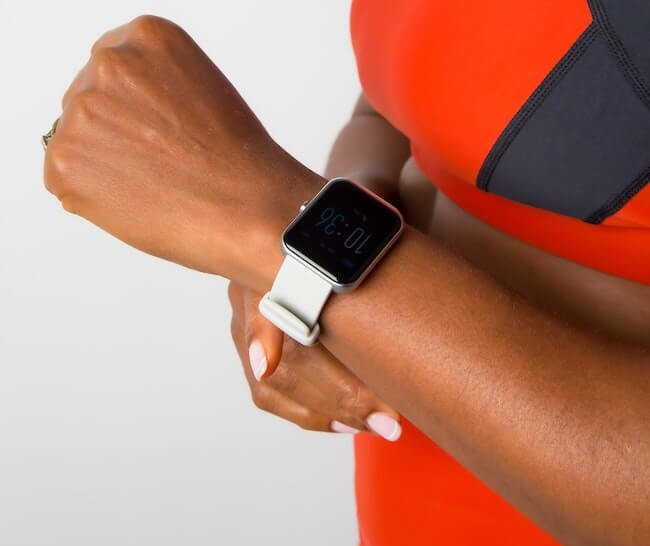You’ve probably heard that you should get 10,000 steps a day (about 5 miles) for better health. And you may be wondering if that’s the right amount for you. Do you need more, or need less? What about other activities, does that count?
Let’s consider that the average American adult takes about 4,000 steps daily1. Jumping from 4,000 steps per day to 10,000 steps is pretty significant. So if that is the golden number, how can you do this safely and make sure you are supporting your body with proper nutrition and hydration?
In this article, we will address how many steps you really need based on your age, goals, and other factors, the benefits of steps, and tips to help you step up your game.
How Many Steps Should You Take A Day For Weight Loss?
The 10,000-step theory started in the 1960s in Japan as a marketing tool for a pedometer.2 It was easy to push the idea of taking 10,000 steps because it was more than what a majority of people obtained in a single day. And generally speaking, more daily movement improves our overall health. So as fitness trackers became popular in the United States, more people strived to hit the goal of 10,000 steps that was embedded in their devices.
However, this theory was not proven nor supported by scientific research for a long time. Research studies now show the health benefits of weight loss, improved blood sugar levels, reduced chronic pain, and more can be obtained with just 7,500 - 8,000 steps per day. Ultimately, the total number that will benefit you depends on factors like age, goals, health history, and weight.
Some women in their 70’s are able to significantly reduce their mortality risk with just 4,400 steps/day.4 On the contrary, children and adolescents gain more benefits from additional exercise every day, and those under 18 years old should reach anywhere from 8,000 - 16,000 steps each day, especially at younger ages when kids are generally more active.5 Here are the recommended daily step counts by age and gender:6
- Recommended Daily Steps for Children and Adolescents Under 18
6,000-15,000 steps. This is a wide range as it depends on the activity level of the child (i.e. do they play sports, regular P.E. class, etc.). But as a general suggestion, you need more steps the younger you are.5
- Recommended Daily Steps for Adults 18-65
6,000-8,000 steps per day is recommended for those aiming to stay healthy, reduce mortality risk, and minimize the risk of chronic disease. For those in this category, 10,000-12,000 steps per day is recommended for weight loss. These numbers are based on research conducted on healthy adults. Anyone with comorbidities should check with their doctor on what number is safest for them.
This can vary based on your current activity/exercise level:
- If you are inactive or just starting your weight loss journey, start with 5,000 steps per day.
- If you are somewhat active (i.e. 30 minutes/day of moderate-intensity activity), aim for 7,500-9,000 steps per day.
- If you are very active (i.e. 30-60 min of vigorous activity each day), anywhere from 10,000-12,500 or more is a reasonable and safe step goal.
- Recommended Daily Steps for Adults Over 65
You can reach your health goals with as little as 3,000-4,000 steps per day and up to 10,000 steps per day. Again, this is dependent on your activity level and health status.
Benefits Of Having A Daily Step Goal
Walking is a great form of low-impact, moderate-intensity physical activity that provides a plethora of health benefits, including:
- Reduced risk of heart disease and diabetes
- Stress management
- Improved mood
- Improved glucose sensitivity and blood sugar levels
- Controlled blood pressure.
- Better weight management and weight loss
It is important to remember the recommended physical activity guidelines when thinking about walking as a form of exercise for these health benefits. The general recommendations for physical activity provided by the U.S Department of Health and Human Services state that adults should obtain at minimum 150 minutes of moderate-intensity activity or 75 minutes of vigorous-intensity activity each week in order to maintain a healthy lifestyle.7 For those with the goal of weight loss and improving their metabolic health, the recommendations double to about 300 minutes of moderate-intensity activity or 150 minutes of vigorous-intensity activity each week.
Walking is considered a moderate-intensity activity when done at a “very brisk” pace (around 3.5-4 miles per hour). Walking for 30 minutes at this pace will equal about 2 miles or roughly 4,000 steps. Walking for 60 minutes at the above pace means you will walk about 4 miles or roughly 8,000 steps. Do this for 5 days during the week, and you will successfully hit the physical activity requirements and your daily step counts all in one.
Walking is a safe, easy, and effective way to reach your weight loss goals and manage your blood sugar levels all while feeling better physically and mentally. Read more about how to walk for weight loss.
{{mid-cta}}
Tips To Get More Steps In Your Day

Going outside or using a treadmill for a 30-60 minute walk is a great way to get the recommended amount of exercise for health and weight loss. But sometimes that may not be doable. Thankfully, there are other ways to increase your step count that won’t take up a huge chunk of time. Here are some ideas on how to easily increase your daily step count:
- Take the stairs whenever possible. This could be at work, at the airport, at the doctor's office - or at home! You can ditch the elevator to get more steps or simply take a 2-3 minute work break to walk up/down the stairs at home.
- Park farther away when going to the store. Finding a parking spot that is further away from the store or location you are going to is an easy way to add in an additional 20-30 steps (one way) or more!
- Walk, don’t drive! If you live close to your destination, consider leaving the car at home and walking to your destination. If you are meeting friends, suggest parking farther away and walking together to the restaurant or meeting spot you plan to go to.
- Walk and talk. Take your phone calls on the move and walk as you talk on the phone. This can be phone calls with loved ones or phone calls for work. You will be surprised how many steps you obtain by pacing around the house or taking the call during a walk outside.
- Walk while you wait. There’s so many minutes and hours spent waiting for different things, like your coffee order, doctor's appointment, or for a flight. Take the additional waiting time to walk around. You can check out some stores nearby or walk around the building (just don’t wander too far!).
Learn More About Fitness and Healthy Habits with Signos’ Expert Advice
Walking is one easy way to create a healthy lifestyle, stay active, lose weight and improve your blood sugar levels. When you pair healthy nutrition habits with walking, you can give your health an added boost.
A continuous glucose monitor (CGM) can give you the insights you need to make smarter nutrition and exercise choices. The Signos app provides a unique, personalizied program to help you lose weight and reach your health goals.
Take this quiz to see if Signos is a good fit for you and reach your goals faster than ever before.
Featured Snippet: The average American adult 18-65 years old takes about 4,400 steps per day; however, the current recommendation for reducing the risk of disease and maintaining a healthy lifestyle is closer to 7,500-10,000 steps. How do I increase my step count safely and how can I use walking to help me lose weight?
- Item 1
- Item 2
- item 3
Topics discussed in this article:
References
- Rieck, Thom. (2020, March 23). 10,000 Steps A Day: Too Low, Too High? Mayo Clinic. https://www.mayoclinic.org/healthy-lifestyle/fitness/in-depth/10000-steps/art-20317391#:~:text=The%20average%20American%20walks%203%2C000,a%20day%20every%20two%20weeks.
- Reynolds, Gretchen. (2021, September 15). Do We Really Need to Take 10,000 Steps A Day for Our Health? The New York Times. https://www.nytimes.com/2021/07/06/well/move/10000-steps-health.html
- Saint-Maurice PF, Troiano RP, Bassett DR, et al. (2020). Association of Daily Step Count and Step Intensity With Mortality Among US Adults. JAMA. 323(12): 1151 – 1160. doi:10.1001/jama.2020.1382.
- Lee, I. M., Shiroma, E. J., Kamada, M., Bassett, D. R., Matthews, C. E., & Buring, J. E. (2019). Association of Step Volume and Intensity With All-Cause Mortality in Older Women. JAMA internal medicine, 179(8), 1105–1112. https://doi.org/10.1001/jamainternmed.2019.0899.
- Tudor-Locke, C., Craig, C. L., Beets, M. W., Belton, S., Cardon, G. M., Duncan, S., Hatano, Y., Lubans, D. R., Olds, T. S., Raustorp, A., Rowe, D. A., Spence, J. C., Tanaka, S., & Blair, S. N. (2011). How many steps/day are enough? for children and adolescents. The international journal of behavioral nutrition and physical activity, 8, 78. https://doi.org/10.1186/1479-5868-8-78
- Holland and Barrett. (2022, June 10). Your Recommended Daily Steps by Age. https://www.hollandandbarrett.com/the-health-hub/weight-management/fitness/exercise/your-recommended-daily-steps-by-age/
- U.S. Department of Health and Human Services. 2018. Physical Activity Guidelines for Americans, 2nd edition. Washington, DC: U.S. Department of Health and Human Services. 1-118. https://health.gov/our-work/nutrition-physical-activity/physical-activity-guidelines/current-guidelines
































